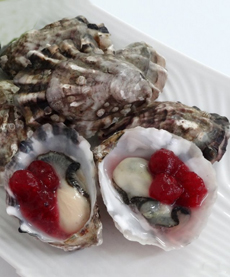RECIPE: Holiday Oysters With Cranberry Cocktail Sauce

Make cranberry cocktail sauce for the holidays. Photo courtesy Willapa Oysters, a NIBBLE Top Pick Of The Week. |
The Pilgrims may well have had oysters at their first harvest feast. We know that mussels were easily picked from rocks along the shore, and oysters were native to the local estuaries, where rivers and streams flowed into the sea.
Oysters are one of our favorite foods, and a very easy course to prepare. We often serve them as an appetizer at Thanksgiving, Christmas and New Year’s Eve dinners. Instead of cocktail sauce—ketchup with horseradish—make it seasonal by mixing cranberry sauce with the horseradish. In addition to oysters on the half shell, you can use it as a condiment with fried or roasted oysters. RECIPE: CRANBERRY COCKTAIL SAUCE You can use any cranberry sauce. For this particular recipe, we use store-bought cranberry sauce since the strong horseradish flavors covers over the flavor nuances of homemade sauce. You can purchase prepared horseradish plain (off white color) or red (enhanced with beets). We tend to buy the red version for color, but you can use either. |
|
|
Ingredients 1. PULSE the cranberry sauce and horseradish to combine. Taste and add more horseradish or a splash of vinegar as desired. 2. TOP the plated oysters with the cocktail sauce. Garnish with lemon zest. Garnish the platter with whole cranberries and greens (we like spinach leaves for a holiday look) and serve. |
||